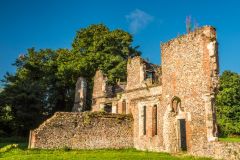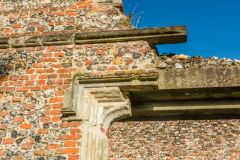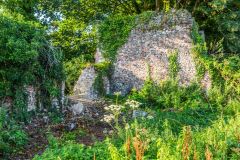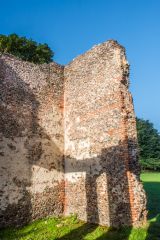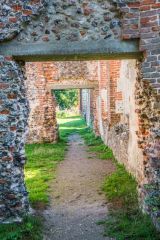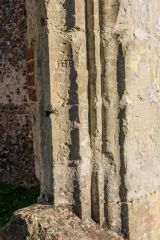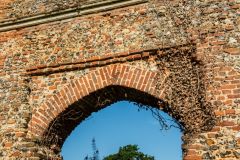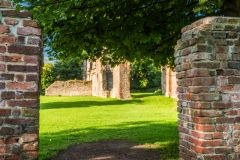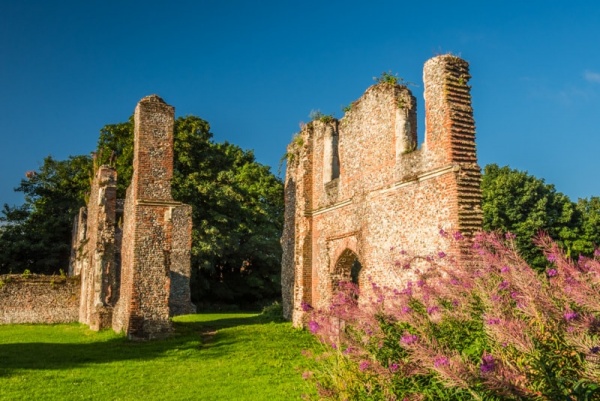
The peaceful River Ver winds its way through the historic city of St Albans. On the south bank of the river is an oasis of green parkland housing allotment gardens and beside the gardens stands one of St Albans' secret delights; the ruins of a 16th-century manor house built on the foundations of a medieval nunnery.
History
The story of Sopwell Nunnery (sometimes called Sopwell Priory) goes back to the early 12th century when a pair of female hermits lived here on the forested land between the river and the Roman Watling Street. The women dwelt in rudimentary shelters made from tree branches with wattle applied to keep out the worst of the weather.
The Abbot of St Albans at the time was Geoffrey de Gorham, and he was so impressed with the piety of the two women that he founded a nunnery on the site.
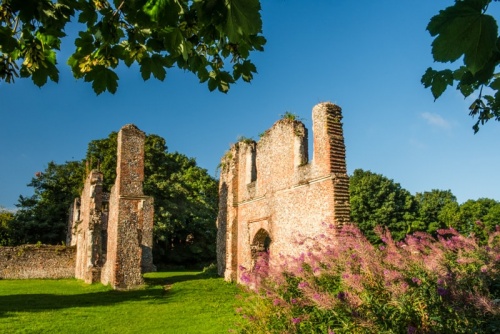
Of course, by doing so he also made sure that the activity of the hermits would now be regulated by the Abbey. He could also move the nuns that had been a part of St Albans Abbey since the Saxon period into the new nunnery and out of the Abbey. No one was permitted to enter the nunnery without permission of the abbot and for the nun's safety and reputation they were to be locked in at night under the abbot's seal.
The nunnery was dedicated to St Mary, but it quickly became known as Sopwell Nunnery due to the fact that the nuns dipped crusts of bread in the waters of a holy well and offered the 'sopped' bread to pilgrims on their way to visit the shrine of St Alban at the Abbey.
The traditional story of Sopwell Nunnery's foundation was written by the medieval historian Matthew Paris. There are some question marks over Paris' accuracy, for according to other sources the first cell occupied by the nuns was an anchorite's cell built - or rebuilt - by a hermit named Roger.
In 1247 Henry III granted a yearly stipend of 50 shillings to support a chaplain whose task was to say the Mass of the Virgin daily.
The number of nuns was limited to 13, and only maidens could be allowed to join the community. By the time Henry VIII suppressed the nunnery in 1537, only five nuns lived there, along with two children, presumably left with the nuns to be educated.
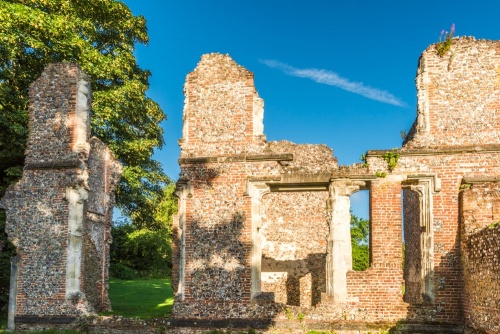
The nunnery was completely dependent on the abbey, but this did not always sit well with the nuns. When the prioress died in 1330 they decided to elect one of their own number, Sister Alice de Hakeneye, to take her place. The abbot hastily sent his prior, Nicholas de Flamstede, to investigate.
Flamstede cleverly declared that though the abbot had the right to name the new prioress, he would be pleased to hear the nun's opinions. Each nun wrote the name of her choice, and the results were 16 in favour of Alice de Hakeneye and three in favour of the sub-prioress, Alice de Pekesden.
Flamstede, apparently acting on orders already given by the Abbot, declared that the new prioress would be Alice de Pekesden. It is curious to note that there were 16 votes cast, though the nunnery was supposed to be limited to a population of 13. There is no record that the nuns ever tried to assert their independence again.
That's not to say that life was dull! In 1428 an outlaw named William Wawe broke into the nunnery with his men. They began to ransack the place but fled when a hue and cry was raised in the village outside the walls. Cardinal Beaufort stopped at Sopwell in 1428, following in the footsteps of the Duke of Gloucester who had visited the previous year.
When the nunnery was dissolved by Henry VIII he granted the land to Sir Richard Lee, a soldier, military engineer, and royal advisor. Lee, in turn, adapted the monastic ruins to create a fashionable manor house which he named Lee Hall (though you will sometimes see it referred to as Sopwell House).
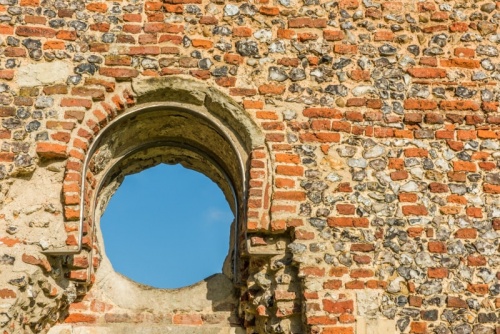
No sooner had Lee finished his mansion then he decided to build a larger, more opulent house on the same spot. He began this new house but died in 1575 before it could be finished.
Lee's new house used the monastic cloister as a courtyard and stood upon the foundations of the nunnery church and conventual buildings. He had the road from London to St Albans moved to create a large park. Construction must have been almost complete in 1564 when Elizabeth I stayed in 'Sir Richard Lee's house at St Albans'.
Large sections of Lee's mansion were taken down and used to rebuild Sir Nicholas Bacon's manor of Gorhambury a few miles away. As for Sir Richard Lee, he was buried in St Pewter's Church. The funeral helmet carried at his burial service is now in the Museum of St Albans on Hatfield Road.
The second mansion was still unfinished in 1669 when the estate was sold by Lee's descendants to Sir Harbottle Grimston of Gorhambury, who used some of the stonework for his own house and sold other carved pieces to Sir Jeremiah Snow for his mansion of Salisbury Hall in Shenley. Several beautifully carved plaster medallions of Roman emperors from Lee Hall can still be seen at Salisbury Hall.
The ruins that we see today are those of the Tudor mansion, though they undoubtedly incorporate stonework from the earlier medieval nunnery. Like so many Tudor houses Lee's mansion was laid out on an H-plan. Visible remains include the gatehouse, kitchens, the west wing and an adjoining cross-wing. The west wing stands to the height of the eaves and is roughly 35m long. Surviving features include windows and doors at ground level, supported by brick arches. The cross-wing shows the vaulting supports for a large staircase.
Excavation of the site in the 1960s revealed that the remains of the nunnery foundations lie beneath the later Tudor house. The layout was apparently a standard Benedictine one, with a church on the north side of a cloister and a chapter house and dormitory on the east side. Remains of 13th century glazed tiles were uncovered along with two burials at the east end of the church.
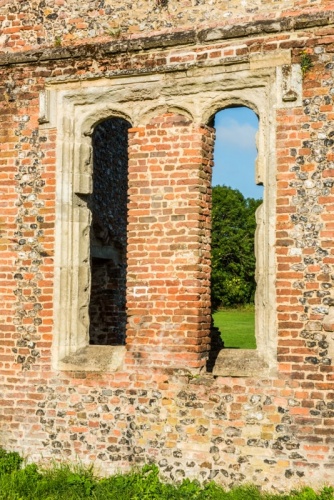
Visiting
Sopwell Nunnery is an open site, accessible at any time. The easiest way to visit is from Cottonmill Lane, between Prospect Road and Old Sopwell Gardens. Note that parking along Cottonmill Lane is very limited but there are several public parking areas along London Road a few minutes walk to the north.
If you prefer to enjoy a lovely walk to the nunnery ruins the site is on both Ver Valley walk 6 and 7. This is the route our family took, strolling along the bank of the River Ver from Alban Way (off the east end of Riverside Road).
The ruins sit in a level green space and make a lovely spot to enjoy a picnic. Note that there are no information panels about the history of the site, nor are there any visitor facilities.
About Sopwell Nunnery
Address: Cottonmill Lane,
St Albans,
Hertfordshire,
England
Attraction Type: Abbey
Location: Open access site, easy to reach off Cottonmill Lane or by the footpath along the south bank of the river.
Website: Sopwell Nunnery
Location map
OS: TL150063
Photo Credit: David Ross and Britain Express
HERITAGE
 We've 'tagged' this attraction information to help you find related historic attractions and learn more about major time periods mentioned.
We've 'tagged' this attraction information to help you find related historic attractions and learn more about major time periods mentioned.
Find other attractions tagged with:
NEARBY HISTORIC ATTRACTIONS
Heritage Rated from 1- 5 (low to exceptional) on historic interest
St Albans South Signal Box and Railway Museum - 0.5 miles (Museum) ![]()
St Albans Cathedral - 0.5 miles (Cathedral) ![]()
St Albans Clock Tower - 0.6 miles (Historic Building) ![]()
St Albans, St Stephen's Church - 0.6 miles (Historic Church) ![]()
St Albans Abbey Gateway - 0.6 miles (Historic Building) ![]()
St Albans, St Peter's Church - 0.8 miles (Historic Church) ![]()
Verulamium Hypocaust and Mosaic - 1 miles (Roman Site) ![]()
St Albans Roman Wall - 1 miles (Roman Site) ![]()
Nearest Holiday Cottages to Sopwell Nunnery:
Holmer Green, Buckinghamshire
Sleeps: 8
Stay from: £2188 - 7957
Bletchley, Buckinghamshire
Sleeps: 6
Stay from: £759 - 2305
More self catering near Sopwell Nunnery
